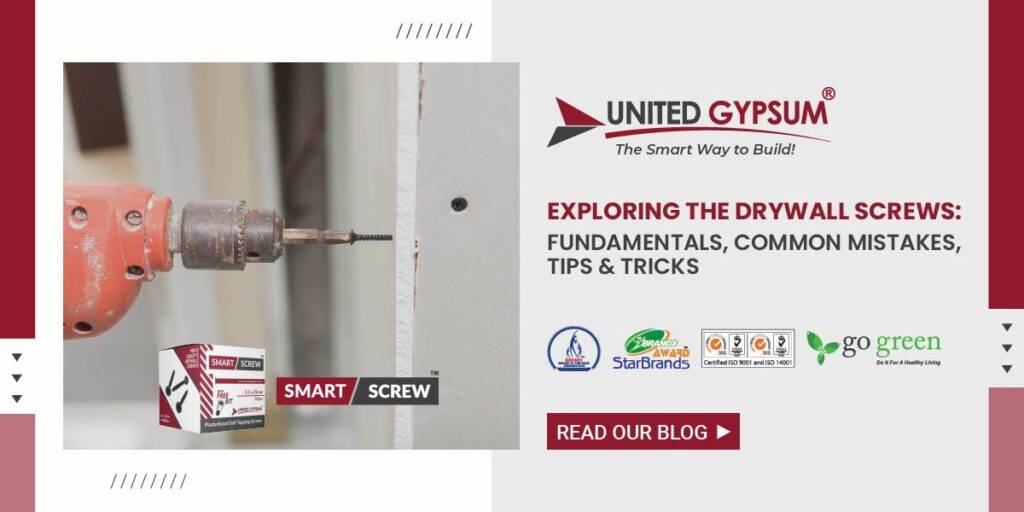Are you contemplating a home renovation project or planning do-it-yourself repairs? If so, you might find yourself in need of some SMART drywall screws. These tiny, seemingly insignificant screws are crucial to the stability and endurance of any drywall installation in the construction industry. This in-depth blog will delve into the world of drywall screws, studying their applications, varieties, sizes, and installation advice.
The Fundamentals of SMART Drywall Screws
Drywall screws, as the name suggests, are specifically designed for securing drywall sheets to studs or framing components, creating a smooth and level surface ready for the application of paint, wallpaper, or any other finishing material. To attach drywall to metal studs, drywall screws called SMART Screws are offered by United Gypsum. These screws have tiny, fine threads running the length of them. They make sure that plaster boards are fastened firmly and securely to metal studs. While they may appear similar to other types of screws, such as wood or metal screws, several important differences that make these drywall screws unique.
The thread design is one of the significant differences. Drywall screws have self-drilling tips with small threads, in contrast to wooden screws, which have aggressive and pointed threads for gripping the material. To guarantee a tight and secure fit, these threads are made to cut into the plasterboard material without causing any harm. Additionally, drywall screws’ bugle-shaped heads aid in countersinking them just under the surface, enabling a smooth and flush finish.
To ensure their strength and endurance, SMART Screws are normally produced from hardened carbon steel. In order to offer corrosion resistance and prevent the screws from rusting over time, the steel is frequently coated with black phosphate or zinc. It’s crucial to use the right screws for your project because utilizing the wrong ones can result in structural damage or other problems like popping and splitting.
Classification of Drywall Screws
Let’s explore the various types and sizes of drywall screws now that we are familiar with their fundamentals. There are generally three primary kinds of drywall screws:
- Fine-threaded Screws: For mounting plasterboard to metal studs or ceiling systems, fine-threaded screws are frequently utilized because they create a solid connection.
- Coarse-threaded Screws: On the other hand, coarse-threaded screws are appropriate for wood framing since they have a higher holding capability.
- Self-drilling Screws: Self-drilling screws are the best choice for use with both metal and wood studs since they do not require pre-drilling, which reduces installation time and effort.
Drywall screws are available in a variety of diameters, usually between 1 and 3 inches in length. 1-1/4 inches is the most popular size for ½-inch thick plasterboard sheets. Longer screws, like those measuring 1-5/8 inches, are typically advised for drywall sheets that are thicker, like 5/8 inch. It’s crucial to pick drywall screws that are the proper length to prevent over- or under-penetration.
Tips and Tricks for a Successful Drywall Installation
There are a few important considerations to make while installing drywall screws. Some of them are as follows:
- Make sure you are properly aware of where the studs or frame members are located first. You can do this by tapping on the wall and listening for a solid sound, or by using a stud finder.
- To offer essential support and avoid any further problems, make sure your screws are hammered into the studs.
- To avoid any cracking or splitting, it is crucial to pre-drill pilot holes in the plasterboard before beginning the installation.
- When working with thicker drywall sheets or close to the edges, where there is a greater risk of damage, this step is very important.
- To facilitate easy penetration without affecting the strength of the drywall, the diameter of the pilot holes should match that of the screws.
- Drive the screws into the pilot holes using a power drill or a screwdriver, stopping just before the head entirely recedes. Overdriving the screws might compromise the finish by causing a dimpling or even tearing of the drywall sheet.
- A minimum 10mm penetration into the metal framing via the board is required for SMART Screws.
- When all the screws are in place, look for any that have protruding heads and countersink them beneath the surface with a drywall knife or a screw gun adaptor.
Some Common Mistakes to Avoid During Drywall Installation
Though it may seem like an easy endeavor, there are a few prevalent errors to avoid when inserting drywall screws. Using the incorrect kind of screws for the task is one of the most frequent errors. As was discussed earlier, substituting wood screws for drywall screws can lead to complications over time including structural deterioration or sagging plasterboard. Purchasing the proper kind of screws for your particular job is always worthwhile.
Another frequent error is inadequate screw spacing. Following a pattern and placing screws every 16 inches along studs or other framework components is advised. Consistent spacing increases stability and stops the drywall from drooping or bulging over time. Screws that are over or under-driven can also cause issues. To produce a flush, clean finish without causing any damage to the plasterboard, it’s critical to strike the appropriate balance.
Ending Note
In conclusion, drywall screws are a crucial component in any project involving the installation or maintenance of plasterboard. Their distinctive design, which includes self-drilling tips, delicate threads, and bugle-shaped heads, enables a safe and expert finish. You may guarantee a successful outcome for your subsequent drywall project by being aware of its intended use, variety of sorts, sizes, and appropriate installation methods. Therefore, plasterboard screws should be your first choice for a job well done the next time you find yourself reaching for some screws.

